
If you’ve ever taken a ceramics class you’ve probably seen that every step has quite a lot of process. When beginning ceramics, one learns the techniques of hand-building, throwing pots on a potter’s wheel, glazing, and firing at a basic level. There is so much to learn within each of these areas of practice that one could spend many years specializing in each one.
Recently a friend and I were marveling at how we used to fire and build kilns “the old-fashioned way” when we were in school together. In our present day clay work, we both use simple but technologically advanced electric powered kilns with computers that can be programmed to make all of the temperature adjustments and ventilation systems that take care of removing atmospheric moisture, and all of this while we are getting a good night of sleep. This is a far cry from 30 years ago when we would stay up all night to make the incremental manual adjustments necessary to heat and vent a gas kiln.
one of my electric computerized kilns in action
a gas kiln in action and top image shows the pyrometric cones that we used to determine the kiln's temperature during a gas firing
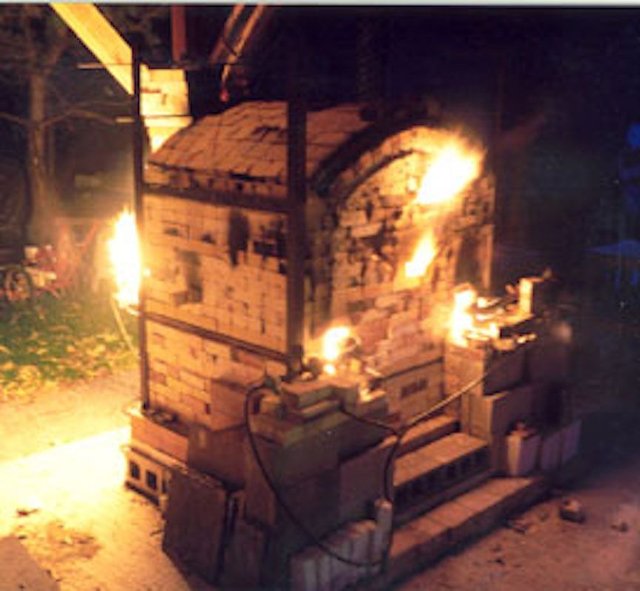
With a non-computerized gas kiln, each adjustment in temperature is make by hand and involves getting the balance of air and fuel just right. The slow heating up and reaching of vitrification temperature is a controlled and intentional process with manual adjustments every hour for 6-18 hours depending on what you’re firing and what kind of kiln.
.jpg)
One of the Raku kilns was on a pulley system
I remember that back then I didn’t really know what I was doing most of the time, but learned from the more advanced and experienced students who generously shared their know-how. Firing an open-flamed gas kiln was a communal and primal ritual that usually involved roasting various things to eat over the fire, often lots of drinking, storytelling and always bonding. Ceramics in general is very communal and to this day I remain connected to my ceramics community old and new.
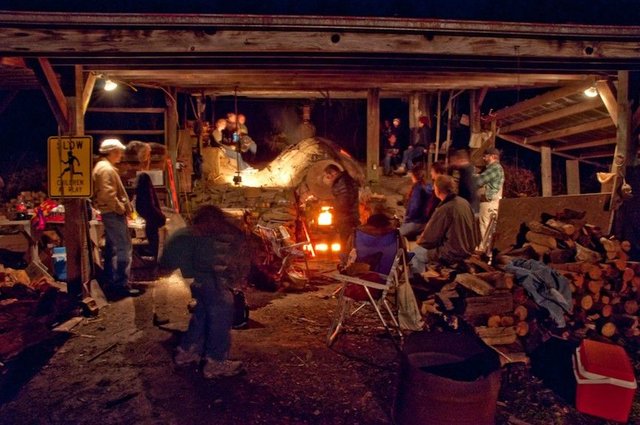
photo credit Richard Yates
Because my professor Paul Soldner was credited for popularizing the firing techniques of Raku and Salt Firing in the United States, Scripps College/Claremont Graduate University where I went to school had a plethora of kilns in the small kiln yard and firing was always an especially important part of the process for any ceramics piece a student made.
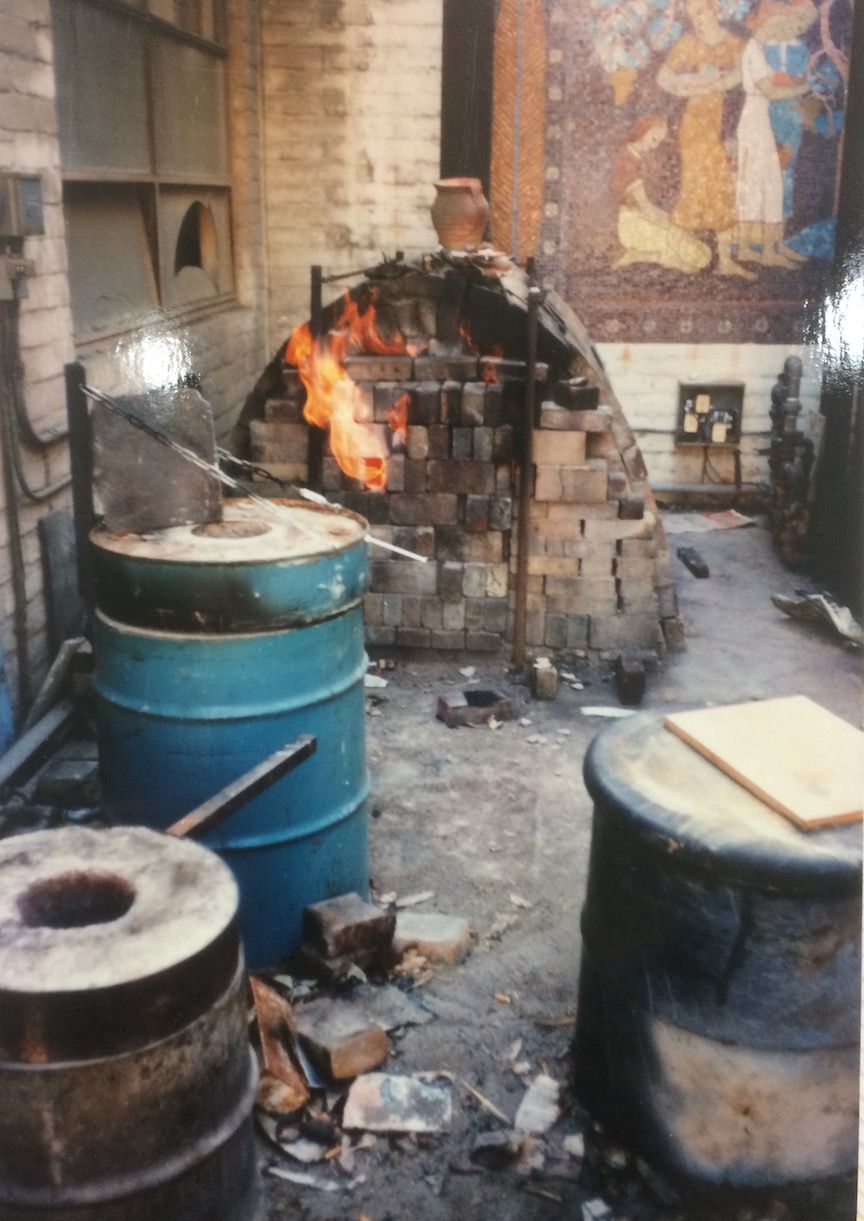
in retrospect this kiln yard at Scripps looks like a huge mess, but at the time it was one of my favorite places on campus! Here a catenary arch kiln in action and in the foreground is another Raku kiln sitting idle
All of our kilns were built as class projects every 5-10 years or so. Soldner was an innovative experimenter and applied his scientific mind to ceramics processes at every turn creating new machinery, techniques, and breaking rules to find simpler ways to solve problems. His teaching was brilliant in that he would break down complex concepts into their simplest foundational components which made even advanced subjects like glaze formulation, kiln-building, and making clay accessible to students.
.jpg)
Paul and Ben Parks in the process of tearing down the catenary arch kiln
During my 2nd year in the program, one of the catenary arch kilns wasn’t working well so Paul decided it was time to remake it and I was lucky enough to participate. This wasn’t glamorous work and every step was incredibly dirty. It involved taking apart the old kiln, cleaning the old mortar and glaze debris from the old firebricks with a chisel, mixing mortar, and carefully following directions to place the bricks in the precise catenary arch formation. Paul and one other advanced graduate students did most of the interesting and skilled work involved.

an LA writer was writing a book on Paul's life and she too helped with this once in a life time opportunity to clean bricks
Although my participation was minimal and manual only, the experience gave me a familiarity and understanding of how kilns work as a result of this construction project. Along with so many other valuable teachings from that time, this kind of foundational knowledge created a kind of “knowing” in my bones that collectively built a reliable intuition that I use every day and in this case informs my decisions when it comes to firing and repairing kilns.
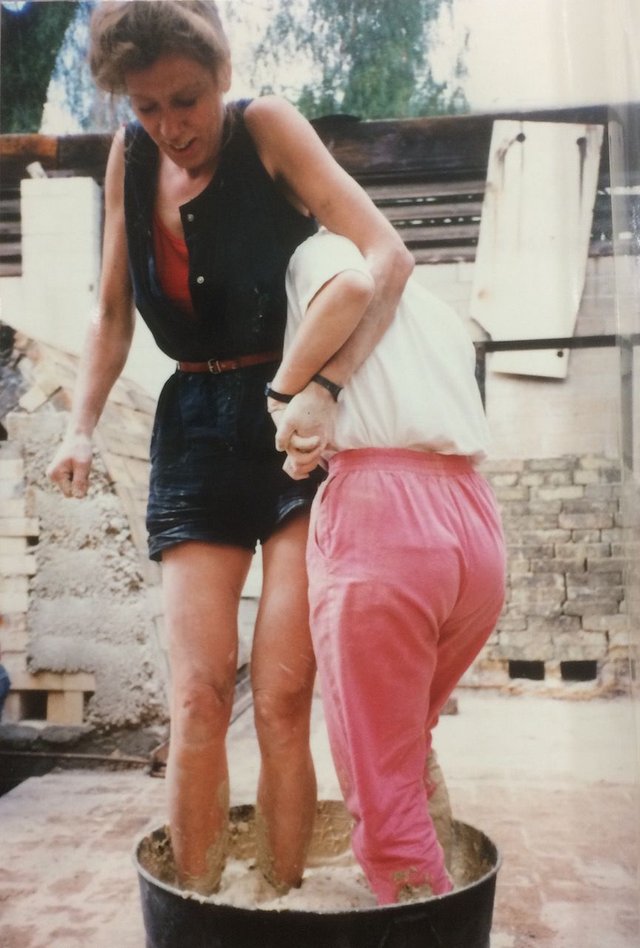
Gifted Netherland artist Wil Van Blokland and I mixed the mortar. She became a good friend and a few years later when I graduated I spent a few months with her at her home and studio in Da Purmerend, the Netherlands)
Firing my electric computer-controlled kilns today is not a particularly romantic nor communal process, but for what I’m doing it serves perfectly well and I have to admit that I enjoy the freedom these kilns offer - sleeping undisturbed through the night for instance! And when I get a hankering for the more primal and interesting firings, I can easily seek out one of the many local gas, Salt and Raku firings that occur regularly at other local studios.
Many thanks for supporting my blog about my art and process, self-mastery, and the nature of things!
If you haven't already contributed to the #actsofkindnesschallenge and want a chance to spread some good vibes, be upvoted, shared by @rebeccaryan and I, here are the details:
https://steemit.com/actsofkindnesschallenge/@rebeccaryan/tell-us-your-random-acts-of-kindness-stories-we-want-to-hear-from-you
https://steemit.com/actsofkindnesschallenge/@natureofbeing/a-random-acts-of-kindness-challenge-your-participation-is-requested
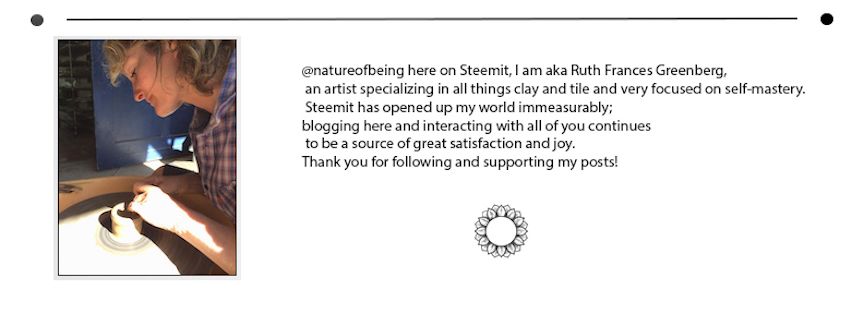
That would have to be one of my favorite parts of the creative process is where your experiences manifest in your work and help to give it the richness and personalized style that difinitively says it's you and yours.
How fortunate you are to have experienced some of your formulative years under the tutelage of such a wealth of dynamism and ground breaking experimentation as your teacher Professor Soldner. Sounds like what a sensei is supposed to be, a teacher still very much into the process themselves.
Often the raw energy and appetite for creating at such a time can be so strong that it carries you through the hard inertia needed to really catalyze into a consummate artisan in your particular avenue of choice.
The communal creative parts sound just divine.
Thanks for the look at other aspects of your artistic creative process.
Impressive.
Great post.
Downvoting a post can decrease pending rewards and make it less visible. Common reasons:
Submit
You are so right - it is incredible good fortune to have such a great teacher! I'm so glad you understood what I was saying about internalizing teaching and experiences so that they inform one's work and practice for years to come. Thanks as always for the extraordinarily attentive reading, I can't tell you how much I appreciate it!
Downvoting a post can decrease pending rewards and make it less visible. Common reasons:
Submit
I really enjoyed reading your article, you write very well! I'm not going to pretend to know anything about kilns but I was very intrigued reading about them, especially the part about restoring the one you mentioned.
There's something magical about watching fire with me. That may sound strange (I'm not a pyromaniac or anything) but I have always enjoyed watching fire. I have a woodstove in my house with a glass window in the door and it is so relaxing for me to just sit in front of it and watch the beauty and different colors of the flames. I tend to drift away in to deep thoughts while watching it. But even though I love the beauty and mystic nature of fire, I also have a tremendous respect for it.
Just talking about it, constantly reminds me of an interesting,exciting and tragic story that I want to share on here soon. I've been wanting to write a book about my life as a peace officer and this incident that I'm thinking of would definitely be in it. I may go ahead and tell the story and just add it later in it's proper section of the book.
Sorry, I'm thinking out loud so to speak and getting off topic lol.
Anyways, thanks for sharing this and I look forward to seeing some of your work!
Downvoting a post can decrease pending rewards and make it less visible. Common reasons:
Submit
thanks for your comment @bluelightbandit and I'm glad to hear you enjoyed my post. Regarding fire, I completely agree - for me it's also completely mesmerizing and a kind of primal centered focus comes over me. I relax profoundly and do some of my best thinking in front of a fire. And indeed we must respect and make friends with this powerful energy!
ps. I enjoyed your musings - yes write it out! I find that steemit can be a great place to try out ideas too.
Downvoting a post can decrease pending rewards and make it less visible. Common reasons:
Submit
I love learning about where and how you were forged as an artist. Your history along with the influences from good friends (who are also artists) and your mentors/teachers will always come through in your art. It's like a bubbling cauldron of creative potential that incorporates how you use your own tools. Love the photos. ;)
Downvoting a post can decrease pending rewards and make it less visible. Common reasons:
Submit
thank you @rebeccaryan! I like your metaphor of a bubbling cauldron of creative potential - so true
Downvoting a post can decrease pending rewards and make it less visible. Common reasons:
Submit
I wonder if the making of your own kiln and fire will be something that is always taught...I hope so, because although outcomes can be unpredictable, the element of surprise when you open the kiln after firing, must be like opening a very unique gift.
Downvoting a post can decrease pending rewards and make it less visible. Common reasons:
Submit
The craft of kiln making is alive and well! There's been a resurgence in the past few years - a sort of back to earth movement that parallels the DIY movement. Although, even an electric kiln has loads of unpredictable outcomes.....frankly control is tricky!
Downvoting a post can decrease pending rewards and make it less visible. Common reasons:
Submit
Hahaha! You're not kidding! Control is tricky.
Downvoting a post can decrease pending rewards and make it less visible. Common reasons:
Submit
This post received a 5% vote by @minnowsupport courtesy of @sammosk from the Minnow Support Project ( @minnowsupport ). Join us in Discord.
Upvoting this comment will help support @minnowsupport.
Downvoting a post can decrease pending rewards and make it less visible. Common reasons:
Submit
This is a really awesome and extensive post @natureofbeing. I am definitely a lover of the clay arts and love to play with them myself along with all things earthy. So glad to come upon your post. Thanks for sharing your passion!
Downvoting a post can decrease pending rewards and make it less visible. Common reasons:
Submit
thanks so much @everlove! I'm so glad to see you here on my blog since I've been a longtime fan of yours :-)). Ceramics is definitely earthy and I too love this. Keep up the great vitality, creativity and passion you display in life!
Downvoting a post can decrease pending rewards and make it less visible. Common reasons:
Submit
Grateful to connect with you here! We have much to share--vitality, creativity and passion!!
Downvoting a post can decrease pending rewards and make it less visible. Common reasons:
Submit
I love this look at things through the lens of your memories. How cool it is you still have these photos, and are willing to share them alongside your experiences with us.
Downvoting a post can decrease pending rewards and make it less visible. Common reasons:
Submit
thanks @crimsonclad, yes it was a LONG time ago and kind of a miracle to have photos of anything from those pre-smartphone days! glad to hear that my reminiscing was worth the read for you.
Downvoting a post can decrease pending rewards and make it less visible. Common reasons:
Submit
This is a nice article. I especially like the kiln pic with the fire coming through the blocks. I am also a ceramics artist, so I appreciate the work involved with creating and firing ceramic art.
Downvoting a post can decrease pending rewards and make it less visible. Common reasons:
Submit
thanks @ixoiru, what kind of ceramic work do you make? i'd like to see, consider posting about it
Downvoting a post can decrease pending rewards and make it less visible. Common reasons:
Submit
You're welcome. I certainly am going to. I'm just getting started here. I've posted a couple of paintings and some writing but i have many things to talk about.
Downvoting a post can decrease pending rewards and make it less visible. Common reasons:
Submit
Fire me up!! I love stoneware and pottery, very awesome and thanks for sharing. <3
Downvoting a post can decrease pending rewards and make it less visible. Common reasons:
Submit
thanks @sammosk, now that would have been a great title!
Downvoting a post can decrease pending rewards and make it less visible. Common reasons:
Submit
This is a terrific post. It must be lot of fun to do ceramics.
I often wonder how our very early ancestors learned these types of things.
I have a feeling it must have been mostly lucky accidents. Ceramics, metals.
Thanks for sharing!
....upvoted and resteemed
Downvoting a post can decrease pending rewards and make it less visible. Common reasons:
Submit
thanks so much @acwood, so glad to hear it! I too have wondered how the early humans learned so many things, in this case it seems to me that the desire to have something to put the food in must have prompted innovation and trial and error. Grateful for your support!
Downvoting a post can decrease pending rewards and make it less visible. Common reasons:
Submit
This is such a beautiful craft.
Downvoting a post can decrease pending rewards and make it less visible. Common reasons:
Submit